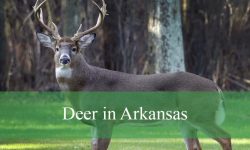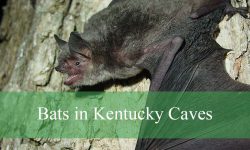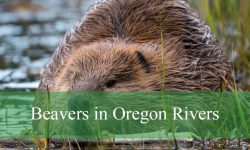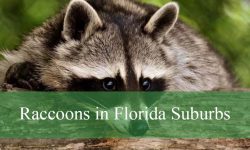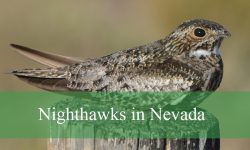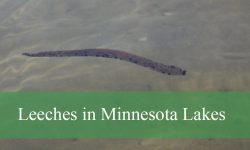Oregon is home to a rich variety of small birds that brighten forests, parks, and backyards throughout the year. From lively chickadees to colorful finches, these birds offer plenty to see for birdwatchers and nature lovers alike.
Many of these small birds have unique markings and behaviors that make them easy to identify once you know what to look for. Exploring dense woodlands or strolling through neighborhoods provides great opportunities to spot these feathered friends.
This guide introduces 32 common small birds found in Oregon, complete with photos and key identification tips. Beginners and experienced birders alike will find helpful information to recognize and appreciate these wonderful birds.
Common Small Birds You Can See in Oregon
Chestnut-backed Chickadee (Poecile rufescens)
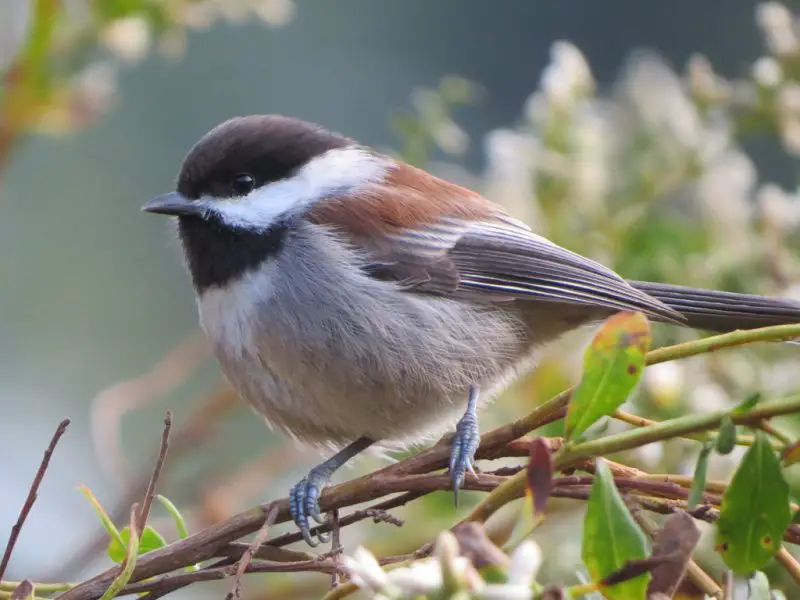
The Chestnut-backed Chickadee is distinguished by its rich chestnut-colored back and flanks, which contrast with its black cap, bib, and white cheeks. This bird is slightly smaller than the Black-capped Chickadee and has a more delicate appearance with a subtle olive-gray tint on its wings and tail. Its striking coloring makes it fairly easy to identify in the dense coastal forests where it most often lives.
This species tends to be shy and less conspicuous but is active and agile while foraging. It mainly feeds on insects and spiders during spring and summer, switching to seeds and berries in colder months. Chestnut-backed Chickadees are known to store food to eat later, a behavior that helps them survive harsher winter conditions. They often form mixed-species flocks with other small birds like nuthatches and warblers.
Chestnut-backed Chickadees are primarily found along the moist coastal forests of western Oregon, favoring old-growth coniferous woodlands. Unlike their Black-capped relatives, they rarely venture far inland. Their preference for dense forest habitats makes them a characteristic bird of Oregon’s Pacific Northwest ecosystem, where they nest in tree cavities or nest boxes.
Black-capped Chickadee (Poecile atricapillus)

The Black-capped Chickadee is a small, plump bird easily recognized by its distinctive black cap and bib contrasted with white cheeks. Its soft gray back and wings blend with a light underbelly, while the tail is long and narrow, helping it balance as it moves quickly through branches. These birds measure about 4.5 to 5 inches in length and have a curious, lively appearance, often cocking their heads when observing their surroundings.
In terms of behavior, Black-capped Chickadees are energetic and social, often seen flitting through trees in small flocks, especially outside of the breeding season. They are known for their iconic “chick-a-dee-dee-dee” call, which serves both as communication and warning to others. These birds are highly adaptable feeders, eating a wide range of insects, seeds, and berries. In winter, they frequently visit bird feeders, attracted by sunflower seeds and suet.
In Oregon, Black-capped Chickadees inhabit mixed woodlands, deciduous forests, and suburban areas with plenty of trees and shrubs. They are year-round residents, although they may shift elevation in winter. These birds nest in tree cavities, often excavated by themselves or taken over from woodpeckers. Their adaptability to different environments and foods allows them to thrive across much of Oregon’s forests and urban green spaces.
Bushtit (Psaltriparus minimus)

Bushtits are tiny, round-bodied birds measuring about 4 inches long, with soft gray or brownish plumage and a relatively long tail. Their small size and subtle coloring make them somewhat inconspicuous, but they often reveal themselves through their constant, restless movement in shrubs and low trees. Males and females look similar, and their small black eyes and short bill are key identification markers.
Bushtits are highly social birds, commonly seen traveling in large flocks of 10 to 40 individuals, especially outside the breeding season. Their behavior includes flitting through dense brush in search of tiny insects and spiders, which make up the bulk of their diet. They are agile and quick, often hanging upside down on branches to glean prey. Bushtits build elaborate, hanging nests from spider silk and plant fibers, usually suspended from thin branches.
In Oregon, Bushtits are widespread, occupying scrublands, open woodlands, and suburban gardens. They prefer habitats with dense understory vegetation where they can forage safely. These birds do not migrate but may move locally to find food. Their presence in Oregon is year-round, with nesting concentrated in spring and early summer, making them a familiar sight in diverse habitats across the state.
Ruby-crowned Kinglet (Corthylio calendula)
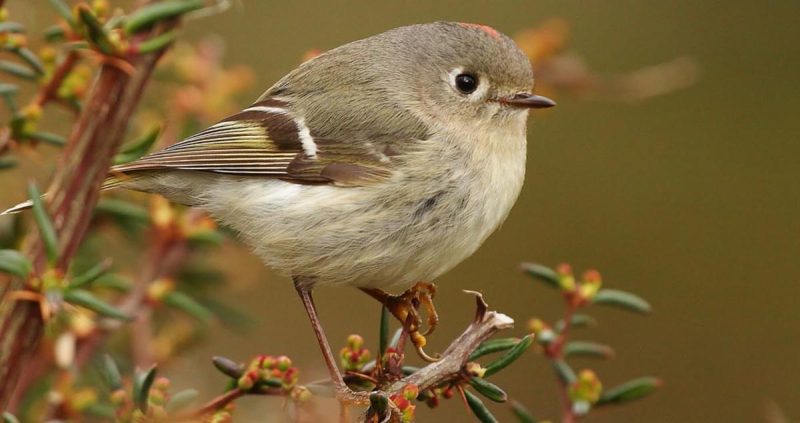
The Ruby-crowned Kinglet is a tiny, active songbird, about 4 inches long, known for the brilliant red patch on the top of the male’s head, which is often concealed and only shown during displays. The overall plumage is olive-green with white wing bars and a pale belly. Their large eyes and thin bill give them a sharp, alert appearance despite their small size.
These kinglets are insectivorous, feeding mainly on small insects and spiders, often caught by hovering or gleaning on foliage. They are highly energetic, constantly flicking their wings and moving rapidly through branches. Ruby-crowned Kinglets breed in coniferous forests but spend winters in a wider variety of habitats including deciduous woodlands and shrublands. Their song is a high-pitched series of notes, adding lively sound to the forests.
In Oregon, Ruby-crowned Kinglets are migratory, arriving in spring to breed primarily in northern and mountainous regions, then moving south or to lower elevations in winter. They favor dense forests with abundant undergrowth and are often seen flitting through trees in mixed-species flocks. Their adaptability to various forest types helps them survive across a wide range of Oregon’s landscapes.
Golden-crowned Kinglet (Regulus satrapa)
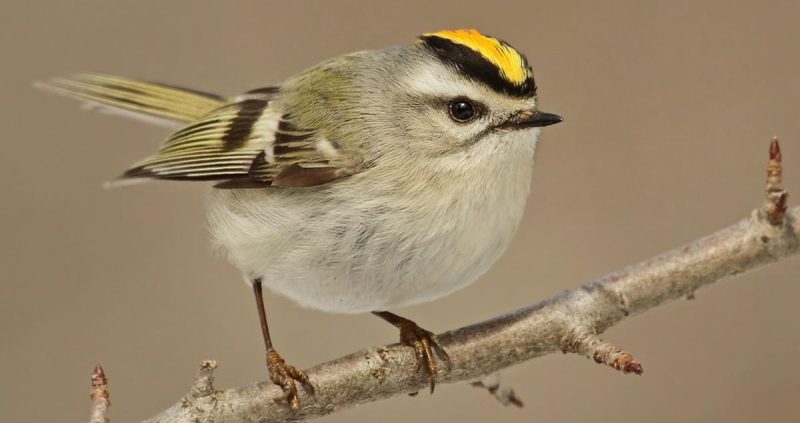
The Golden-crowned Kinglet is one of the smallest birds in North America, similar in size to the Ruby-crowned Kinglet but distinguished by a bright yellow and orange crown patch bordered by black stripes. The body is olive-gray with white wing bars and a pale underside. Their tiny size and quick movements make them challenging to spot, but the golden crown shines during courtship or when agitated.
Golden-crowned Kinglets are insectivores that glean small insects and spiders from tree branches, often hovering briefly to snatch prey. Their high-energy behavior includes constant wing flicking and rapid, agile movements through conifers. They breed in dense, mature coniferous forests and are well adapted to cold climates. Their high-pitched, thin calls help them communicate in thick forest canopies.
In Oregon, Golden-crowned Kinglets are mostly found in mountainous areas and higher elevations during breeding season, favoring dense spruce and fir forests. They migrate to lower elevations or milder coastal forests in winter but remain within the state year-round. Their preference for coniferous habitats aligns well with Oregon’s rich forest ecosystems, making them a common, though easily overlooked, resident.
Pacific Wren (Troglodytes pacificus)
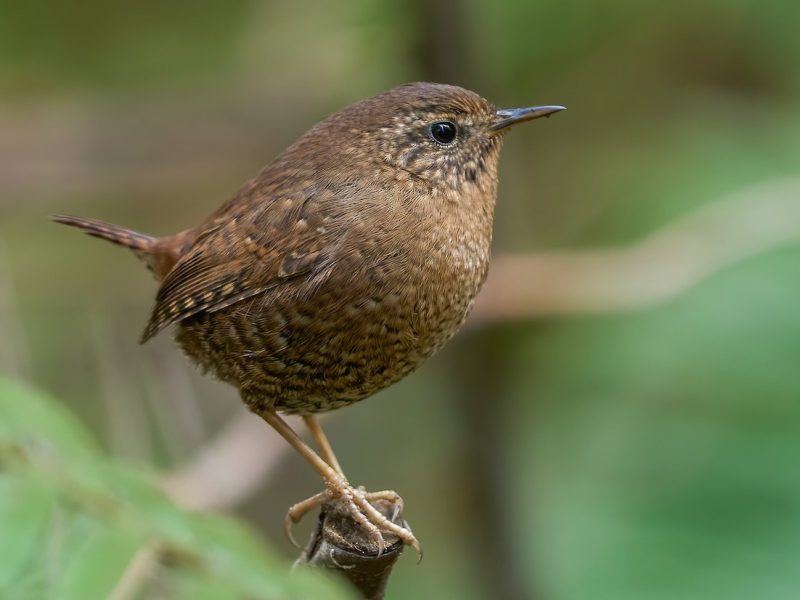
The Pacific Wren is a small, compact bird measuring about 4 inches in length, with rich brown plumage streaked with darker barring on its wings, tail, and back. Its short tail is often held upright, a typical wren characteristic, and it has a fine, slightly curved bill. This bird’s subtle but intricate patterning helps it blend into the dense underbrush and mossy forest floors where it lives.
Known for its loud, complex, and musical song, the Pacific Wren is an energetic forager, constantly hopping and probing in dense shrubs, fallen logs, and leaf litter. It mainly feeds on insects and spiders, gleaning them from crevices and foliage. This species prefers moist coniferous and mixed forests, thriving in the thick understory and old-growth areas where it can find ample food and nesting sites.
In Oregon, Pacific Wrens are common residents in the western part of the state, especially in coastal and mountainous forest regions. They nest in natural cavities or mossy crevices close to the ground, often hidden deep in tangled vegetation. Their presence is notable year-round, and their rapid, bubbly song is a distinctive sound of Oregon’s forest understory.
Bewick’s Wren (Thryomanes bewickii)
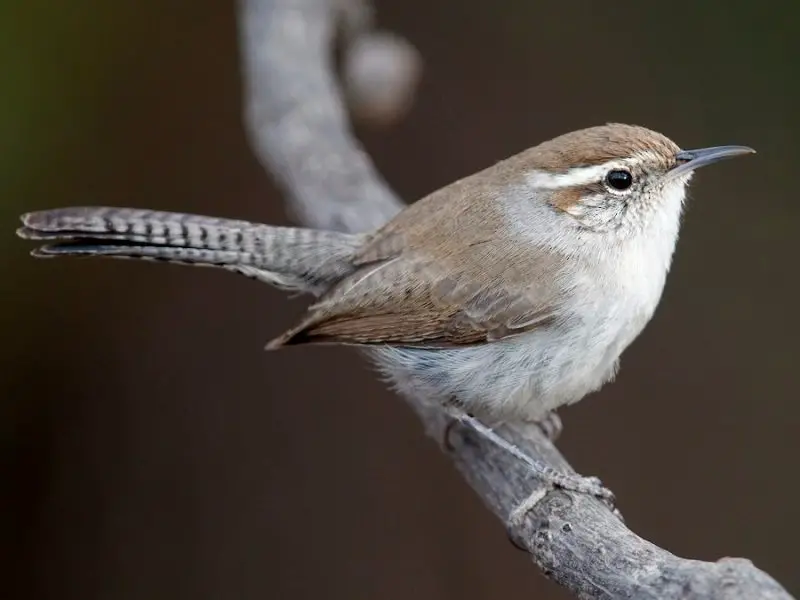
Bewick’s Wren is a slender, medium-sized wren measuring about 5 to 6 inches long, with warm brown upperparts and a pale, buffy underside. It has a long, slightly curved tail with dark barring and a distinct white eyebrow stripe that makes identification easier. The bird’s slim build and longer tail give it a graceful appearance compared to other wrens.
This species is highly adaptable and often found in open woodlands, scrublands, and suburban areas with scattered trees and shrubs. Bewick’s Wrens are active and vocal, known for their loud, varied songs and mimicry of other bird calls. They forage mainly on insects and spiders, frequently searching crevices in bark and foliage. Bewick’s Wrens build dome-shaped nests hidden in dense shrubs or cavities.
In Oregon, Bewick’s Wrens inhabit drier habitats in the eastern and southern parts of the state, including sagebrush and chaparral areas. Unlike the Pacific Wren, they are less associated with dense forests and more common in semi-arid environments. They are year-round residents in these regions and often adjust well to human-altered landscapes.
House Wren (Troglodytes aedon)
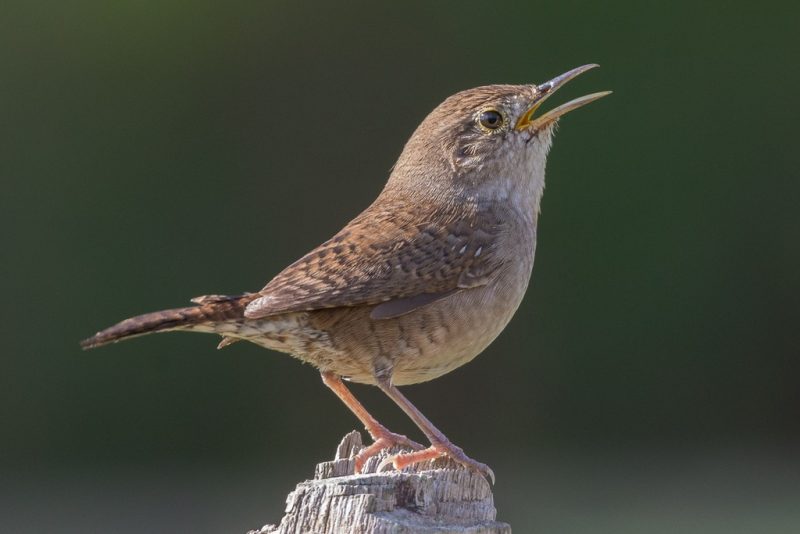
House Wrens are small, lively birds roughly 5 inches long, characterized by their brownish-gray plumage with subtle barring on the wings and tail. Their short wings and tail, along with a fine bill, make them agile flyers, able to maneuver quickly through dense brush or urban gardens. Despite their modest coloring, they are easily recognized by their bubbly, rapid song.
These wrens are highly adaptable, thriving in open woodlands, gardens, and suburban areas. They are cavity nesters, often using birdhouses, mailboxes, or crevices around buildings to raise their young. House Wrens feed primarily on insects and spiders, actively hunting by gleaning and probing in shrubs and on the ground. Their bold and inquisitive nature often brings them close to human habitations.
In Oregon, House Wrens are migratory, arriving in spring and staying through summer for breeding before heading south for the winter. They can be found throughout much of the state in suitable habitats, from lowland urban areas to forest edges. Their versatility with nesting sites and diet allows them to flourish across Oregon’s diverse environments during their breeding season.
Marsh Wren (Cistothorus palustris)
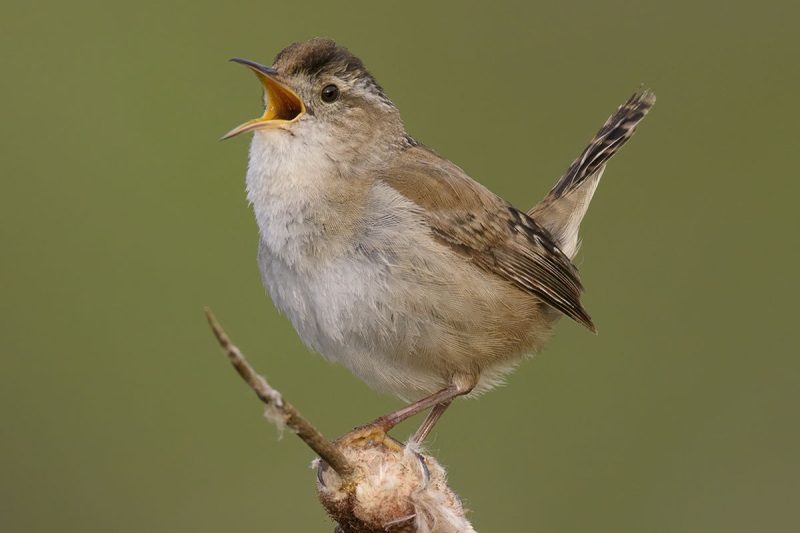
The Marsh Wren is a small, slender bird about 4.5 to 5 inches in length, with a brown back streaked with black and white wing bars. It has a distinctive white eyebrow stripe and a slightly curved bill. Its plumage is well suited for blending into marshy reeds and cattails, the typical environment where it lives and breeds.
Behaviorally, Marsh Wrens are territorial and vocal, known for their bubbly and harsh calls heard across wetlands. They build elaborate, woven nests suspended among reeds, often several nests in one territory. Their diet consists mainly of insects, spiders, and aquatic invertebrates, which they hunt by probing reeds and cattails in marshes and swamps.
In Oregon, Marsh Wrens are commonly found in freshwater marshes, wet meadows, and estuaries, especially in the Willamette Valley and coastal wetlands. They are migratory and typically present during spring and summer breeding seasons, departing for warmer areas in winter. Their reliance on healthy wetland habitats makes them good indicators of wetland ecosystem health in the region.
American Goldfinch (Spinus tristis)
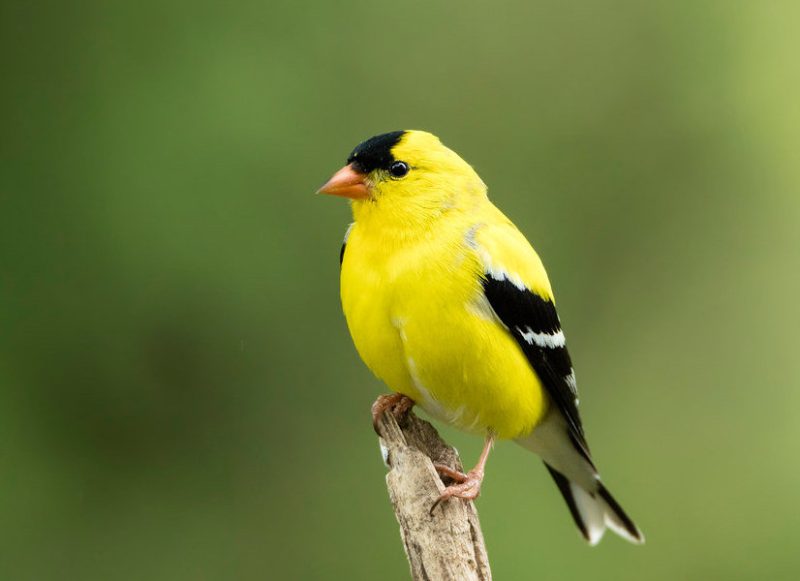
The American Goldfinch is a small, vibrant songbird about 4.5 inches long, easily recognized by its bright yellow plumage with black wings and a black forehead patch in males during the breeding season. Females and winter males have a more subdued olive-yellow color. Its conical bill is perfect for extracting seeds, which are its primary diet.
American Goldfinches are sociable and often seen in small flocks outside of the breeding season. They are seed specialists, particularly fond of thistle, sunflower, and other small seeds. Their undulating flight and cheerful, twittering calls make them a favorite among birdwatchers. These birds prefer open fields, meadows, gardens, and areas with abundant seed-producing plants.
In Oregon, American Goldfinches are widespread and common across the state year-round, from urban parks to rural farmlands. They nest late in the summer to align with peak seed availability, often building cup-shaped nests woven with plant fibers. Their adaptability to a range of open habitats makes them a prominent and colorful presence in Oregon’s bird community.
Lesser Goldfinch (Spinus psaltria)
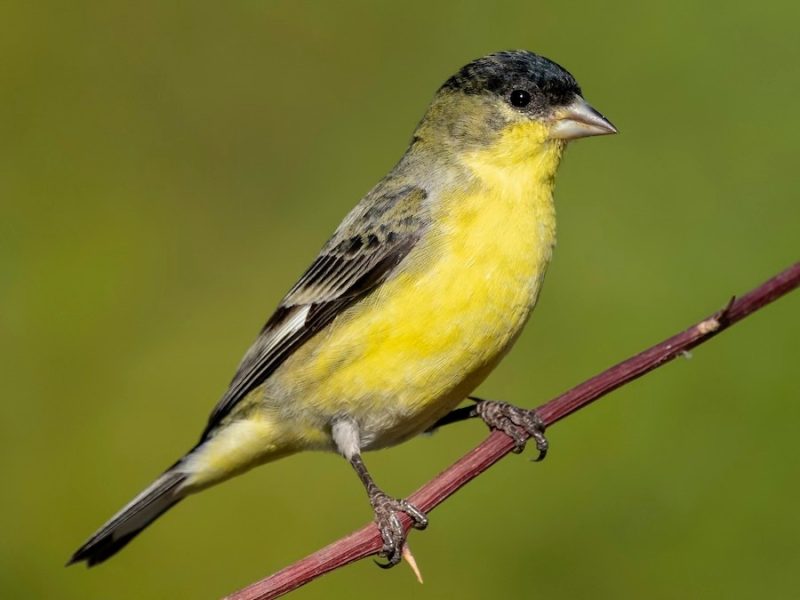
The Lesser Goldfinch is a small, lively finch about 4 inches long, notable for its striking coloration. Males typically display a glossy black cap and back contrasted with bright yellow underparts, while females and juveniles have a more muted olive-green and yellow plumage. Their short, conical bill is perfectly suited for extracting seeds from small flowers and plants.
Behaviorally, Lesser Goldfinches are active and social birds, often seen in loose flocks feeding on seeds and occasional insects. They have a rapid, warbling song and are frequent visitors to backyard feeders, especially those stocked with sunflower and nyjer seeds. Their feeding habits are highly adaptable, allowing them to exploit a variety of seed sources across seasons.
In Oregon, Lesser Goldfinches are most commonly found in the southern and western regions, favoring open woodlands, scrublands, and suburban gardens. They are generally year-round residents in warmer areas but may move slightly with changing food availability. Their preference for open habitats with ample seed-producing plants allows them to thrive in Oregon’s diverse ecosystems.
Pine Siskin (Spinus pinus)
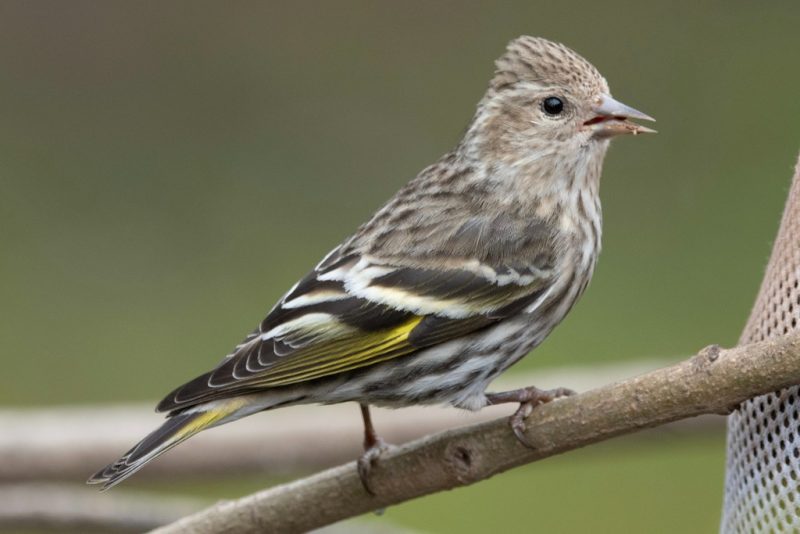
The Pine Siskin is a small finch, about 5 inches long, with streaky brown and white plumage accented by distinctive yellow edging on the wings and tail. Its slender, pointed bill is adapted for extracting seeds from conifers and weeds. Pine Siskins are somewhat nondescript in color but are identifiable by their active foraging and sharp calls.
These birds are nomadic and highly social, often forming large flocks that can move widely in search of food. Pine Siskins primarily feed on seeds from conifers, weeds, and thistles, but will also consume insects during the breeding season. Their rapid, chattering calls and flitting movements through tree branches make them a lively presence in forested areas.
In Oregon, Pine Siskins breed in coniferous forests at higher elevations and are common in the Cascade and Coast Ranges. They may descend to lower elevations or urban areas in winter when seed availability changes. Their presence varies year to year based on food supply, reflecting their nomadic lifestyle in the region.
Red-breasted Nuthatch (Sitta canadensis)
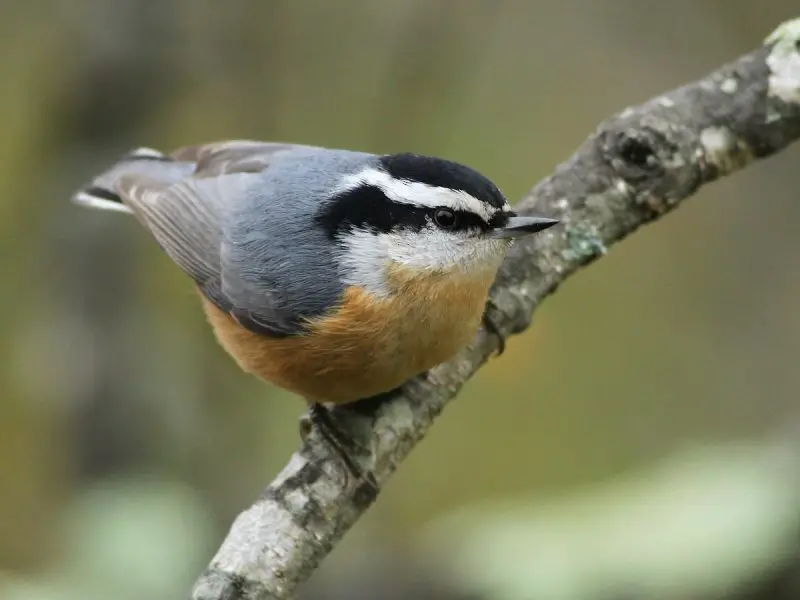
The Red-breasted Nuthatch is a small, compact bird about 4.5 inches long, easily recognized by its slate-blue back, reddish underparts, and distinctive black-and-white facial stripes. It has a sharp, slightly upturned bill that helps it pry insects from tree bark. This species is highly agile, often climbing headfirst down tree trunks.
Behaviorally, Red-breasted Nuthatches are active and vocal, frequently heard giving their nasal “yank-yank” call. They forage by probing and hammering on conifer bark to extract insects, seeds, and sap. These birds often cache seeds to eat later and nest in tree cavities, sometimes enlarging holes with mud to fit their needs.
In Oregon, Red-breasted Nuthatches are common year-round residents in coniferous forests throughout the state, particularly in higher elevations and dense pine or fir stands. Their dependence on mature forests with plentiful bark insects makes them an important part of Oregon’s forest ecosystems.
White-breasted Nuthatch (Sitta carolinensis)
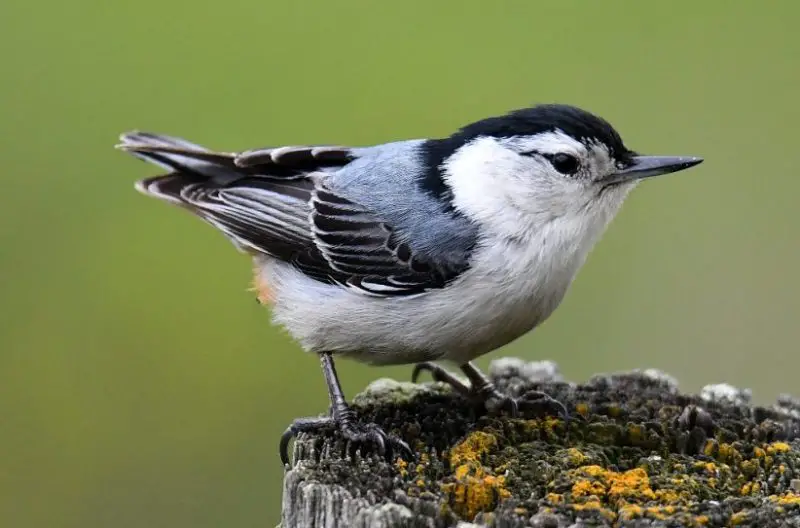
The White-breasted Nuthatch is a medium-sized nuthatch, about 5 inches long, with a white face and underparts contrasting sharply with a blue-gray back and a black cap on the head. Its stout, pointed bill is ideal for extracting insects and seeds from bark crevices. It is known for its unique ability to climb down trees headfirst with ease.
These nuthatches are curious and bold, often seen moving methodically up and down trunks and branches while searching for food. Their diet includes insects, seeds, and nuts, and they frequently visit backyard feeders. White-breasted Nuthatches have a distinctive nasal call and build nests in tree cavities, sometimes modifying the entrance with mud.
In Oregon, White-breasted Nuthatches are widespread across a variety of forest types and suburban areas, favoring mature deciduous and mixed woodlands. They are permanent residents year-round and adapt well to urban parks and gardens, making them a familiar bird in many parts of the state.
Brown Creeper (Certhia americana)
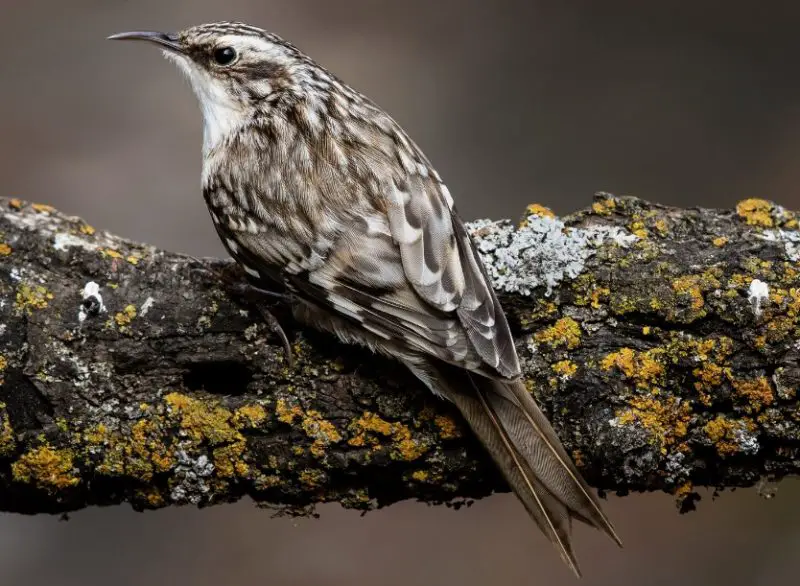
The Brown Creeper is a small, slender bird about 5 inches long, with mottled brown and white plumage that provides excellent camouflage against tree bark. It has a thin, down-curved bill perfect for extracting insects hidden in bark crevices. Its behavior is characterized by spiraling up tree trunks as it searches for food.
Brown Creepers forage by creeping upward in tight spirals on tree trunks and large branches, probing with their slender bill for insects, spiders, and larvae. They often start near the base of a tree and work their way toward the canopy. Their soft, high-pitched calls are often heard but the birds themselves are well hidden.
In Oregon, Brown Creepers inhabit mature forests and wooded parks throughout the state, favoring areas with large, old trees. They are year-round residents, often seen in coniferous and mixed forests where they play an important role in controlling bark insect populations. Their cryptic plumage and secretive habits make them a subtle but fascinating bird to spot.
Song Sparrow (Melospiza melodia)
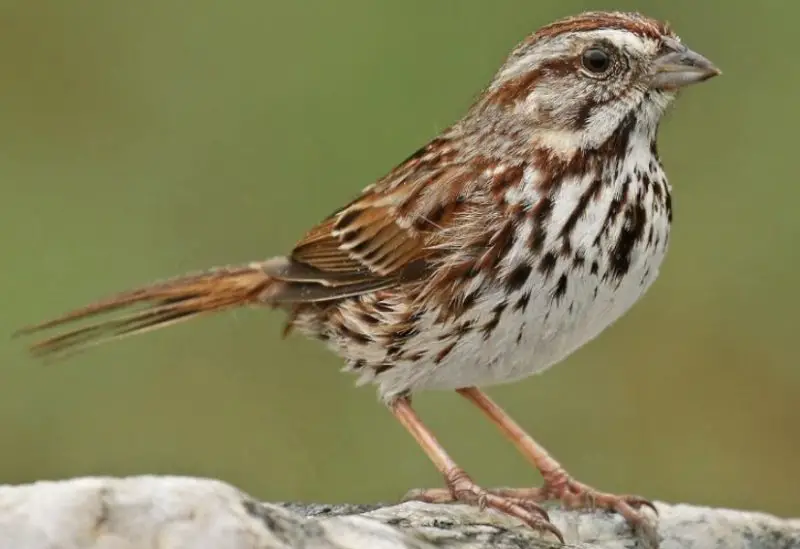
The Song Sparrow is a medium-sized sparrow, about 6 to 7 inches long, recognized by its streaked brown plumage and a distinctive dark spot in the center of its breast. Its broad tail and rounded head give it a stocky appearance. The bird’s variable markings often include streaks across its chest and a mix of brown, gray, and white feathers, making identification interesting due to regional differences.
Song Sparrows are highly adaptable and vocal birds, known for their rich and complex songs that vary widely among individuals. They forage on or near the ground, feeding mainly on seeds, insects, and small fruits. Their behavior includes hopping through low shrubs or grassy areas, and they build cup-shaped nests low in thick vegetation or shrubs to protect their young.
In Oregon, Song Sparrows are common year-round residents across a wide range of habitats, from wetlands and riparian zones to suburban gardens and open fields. Their versatility in habitat preference allows them to thrive in both urban and rural environments throughout the state.
Fox Sparrow (Passerella iliaca)
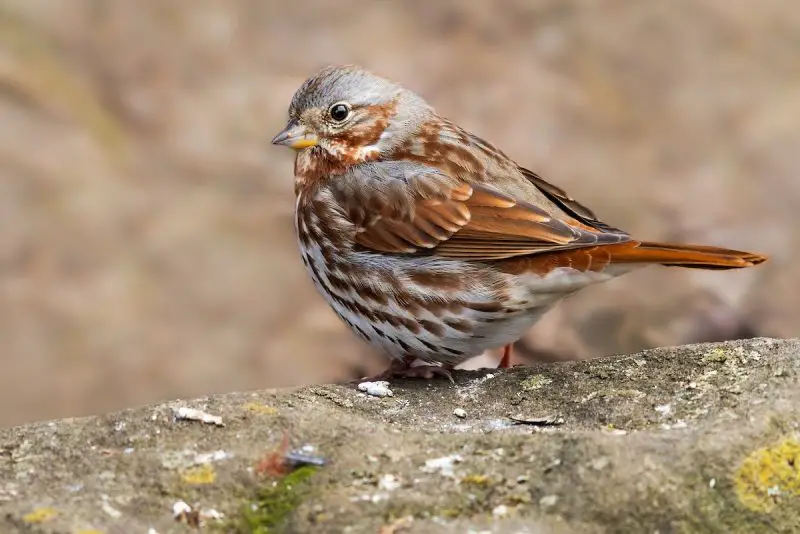
The Fox Sparrow is a large, robust sparrow about 7 inches long, notable for its warm reddish-brown plumage with bold streaking on the chest and flanks. Its thick bill and rounded head give it a chunky, powerful look. These birds often have a rusty-colored back and wings, which help them blend into dense brush and leaf litter.
Fox Sparrows are primarily ground foragers, searching leaf litter for insects, seeds, and berries. They are shy but can be observed flicking their tails and hopping through dense undergrowth. During the breeding season, they sing rich, varied songs that can be heard across thick forests and shrublands.
In Oregon, Fox Sparrows breed in dense forests and shrubby areas mostly in the mountains and coastal regions. They are migratory, spending winters in the lower elevations and thickets of the state. Their preference for dense cover and ground-level foraging distinguishes them from many other sparrows.
Golden-crowned Sparrow (Zonotrichia atricapilla)
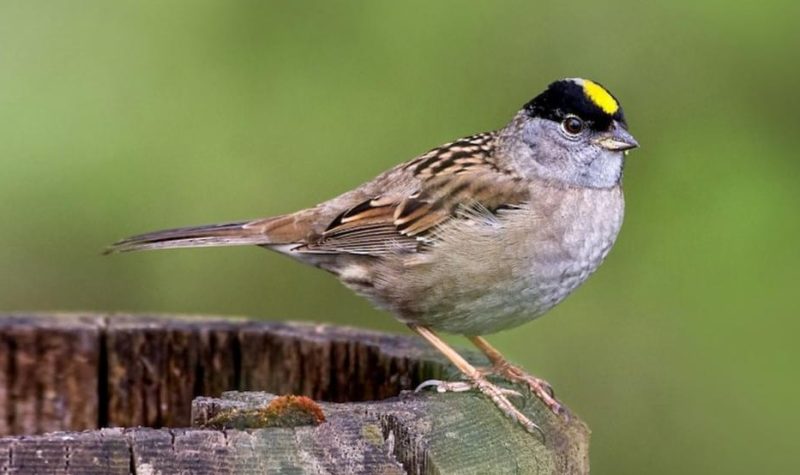
The Golden-crowned Sparrow is a medium-sized sparrow, approximately 6 inches long, easily identified by the striking yellow patch on its crown bordered by black stripes. Its gray face and breast, along with brown streaked wings and back, provide a subtle contrast to the bright crown. Juveniles lack the crown marking, making them more challenging to identify.
These sparrows are primarily ground feeders, eating seeds, berries, and insects found among leaf litter and shrubs. They are social birds, often found in loose flocks during migration and winter. Their soft, mellow whistles and calls give them a gentle presence in their habitats.
In Oregon, Golden-crowned Sparrows are common winter visitors, arriving in fall and staying through early spring. They favor brushy areas, open woodlands, and gardens, especially near the coast and lower elevations. Their seasonal movements bring them to Oregon from their breeding grounds further north and inland.
White-crowned Sparrow (Zonotrichia leucophrys)
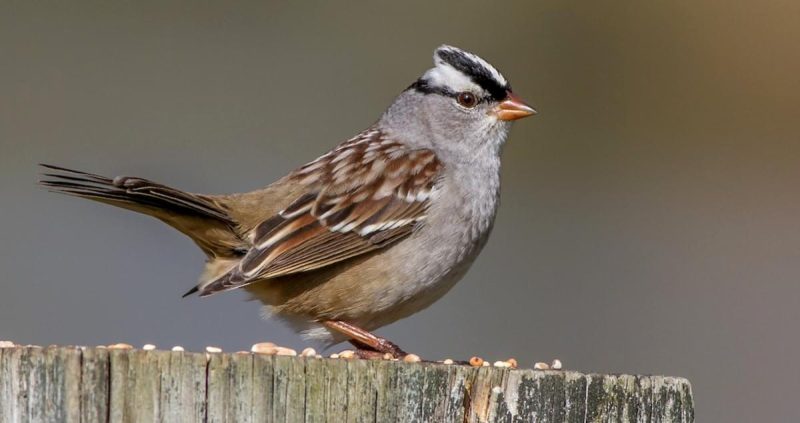
The White-crowned Sparrow is a striking medium-sized sparrow, about 6 to 7 inches long, famous for its bold black and white stripes on the crown and gray face. Its pale underparts and brown-streaked back provide a clean contrast, making it one of the more easily recognizable sparrows. Juveniles have brown and tan stripes instead of black and white.
These birds are ground foragers, feeding on seeds, insects, and small fruits. They are often seen hopping and scratching through leaf litter or open ground, and their clear, whistled song is distinctive during the breeding season. White-crowned Sparrows are somewhat shy but will visit feeders during migration.
In Oregon, White-crowned Sparrows breed in alpine and subalpine habitats and migrate to lower elevations and valleys during winter. They are common throughout the state during migration periods and winter months, found in brushy areas, fields, and gardens, especially in the Willamette Valley and coastal zones.
Dark-eyed Junco (Junco hyemalis)
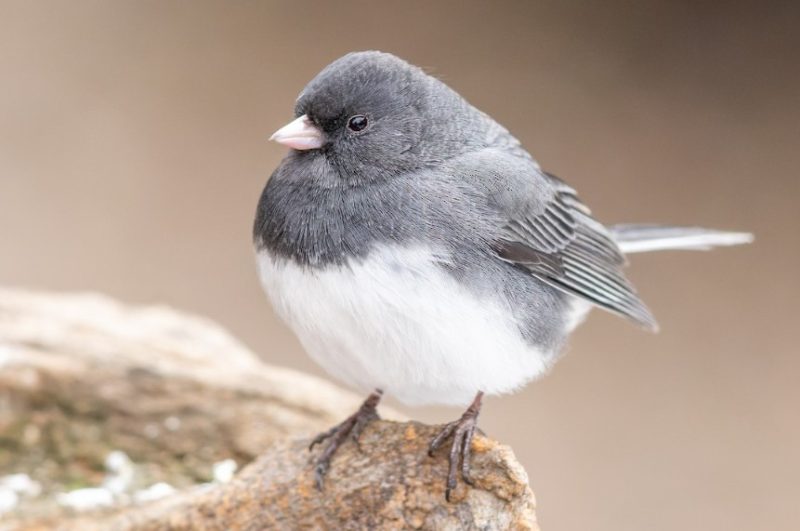
The Dark-eyed Junco is a small, sparrow-like bird about 5 to 6 inches long, with a rounded head and a distinctive coloration pattern that varies by region. The most common “Oregon” form shows a slate-gray head and upper body with a white belly and pink bill. Other forms range from brown to almost entirely black, but all share a clean, crisp appearance.
These birds are ground foragers, feeding mainly on seeds and insects, often seen hopping through leaf litter and open woods. They are known for their sudden, bounding flight and soft, musical trill calls. Juncos often flock together in winter, moving between forest edges and open fields.
In Oregon, Dark-eyed Juncos are abundant year-round residents and migrants. They breed in mountainous forests and spend winters in lower elevation woodlands, parks, and suburban yards. Their adaptability to various habitats and climates makes them one of the most familiar and widespread sparrows in the state.
Spotted Towhee (Pipilo maculatus)
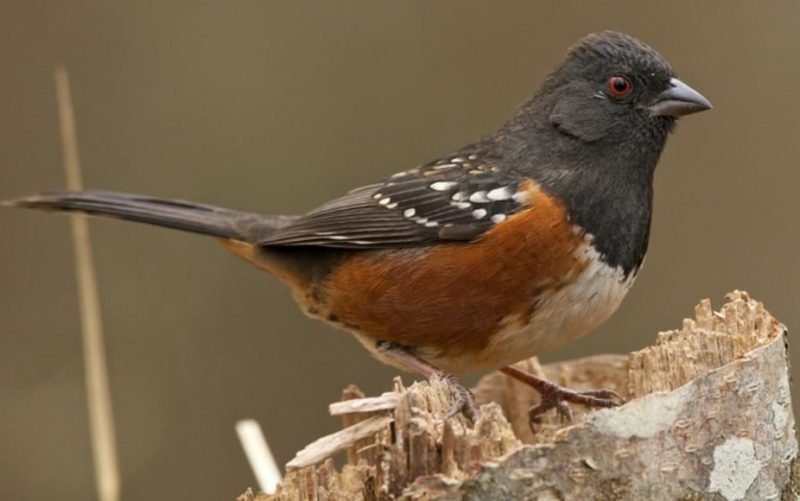
The Spotted Towhee is a striking medium-sized sparrow about 7 to 8 inches long, known for its bold black head, throat, and back contrasted with white spots on the wings and back. Its bright rufous sides and white belly further distinguish it from similar species. The thick bill and long tail, often flicked upward, give the bird a robust and active appearance.
Behaviorally, Spotted Towhees are ground foragers, commonly seen scratching leaf litter with both feet to uncover seeds, insects, and other small invertebrates. They prefer dense shrubbery and thickets for cover and nesting, where they build cup-shaped nests low to the ground. Their sharp, buzzy call and loud “towhee” song are characteristic sounds in their habitat.
In Oregon, Spotted Towhees are year-round residents, widespread across woodland edges, brushy areas, and suburban gardens throughout the state. They thrive in habitats with dense undergrowth and are often heard before they are seen, making them a familiar presence in Oregon’s varied landscapes.
American Tree Sparrow (Spizelloides arborea)
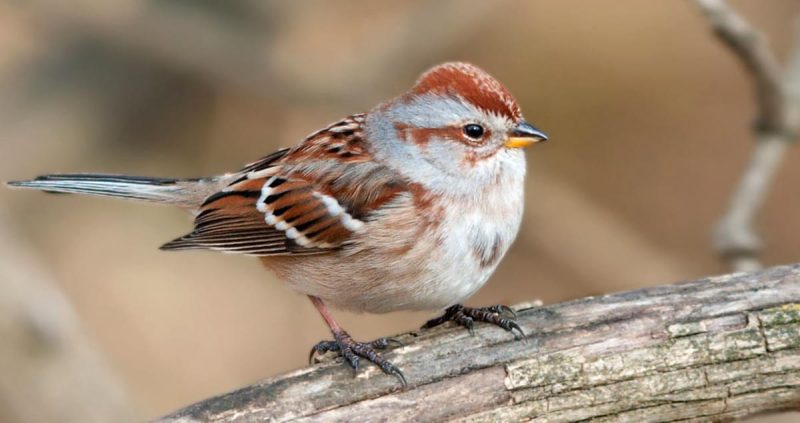
The American Tree Sparrow is a small sparrow roughly 6 inches long, notable for its warm brown crown with a distinct central chestnut stripe and a gray face marked by a rusty line through the eye. Its clean, pale underparts and finely streaked brown back distinguish it from similar sparrows. The bill is short and conical, ideal for seed eating.
American Tree Sparrows are ground feeders that prefer open fields, tundra, and brushy edges, often seen foraging for seeds mixed with insects and berries during the breeding season. Their soft, sweet trills and calls carry well across open habitats. They build nests on or near the ground, usually concealed in dense vegetation.
In Oregon, American Tree Sparrows are primarily winter visitors, arriving in late fall and staying through early spring. They are found in open habitats such as agricultural fields, marsh edges, and shrublands, particularly in the eastern and southern parts of the state. Their presence marks the colder months, as they migrate from northern breeding grounds.
Chipping Sparrow (Spizella passerina)
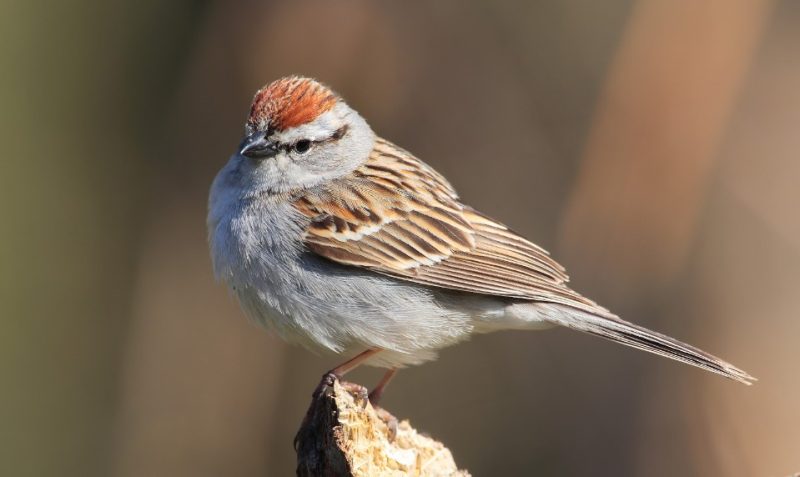
The Chipping Sparrow is a small, slim sparrow measuring about 5 inches long, easily identified by its bright rusty cap, black eye line, and white supercilium (eyebrow). Its grayish face and chest contrast with warm brown wings and a clean white belly. This bird’s sharp, trilled song is one of the most recognizable sparrow sounds.
These sparrows are versatile feeders, primarily consuming seeds and insects, often foraging on the ground or in low vegetation. They are common in open woodlands, parks, and suburban areas where they build neat cup-shaped nests in trees or shrubs. Chipping Sparrows are active and social, often forming small flocks outside of the breeding season.
In Oregon, Chipping Sparrows are widespread breeders found from lowlands to mountainous regions. They are present throughout spring and summer, favoring open forest edges, residential areas, and grassy clearings. Their bright cap and lively song make them easy to spot during the breeding season.
Savannah Sparrow (Passerculus sandwichensis)
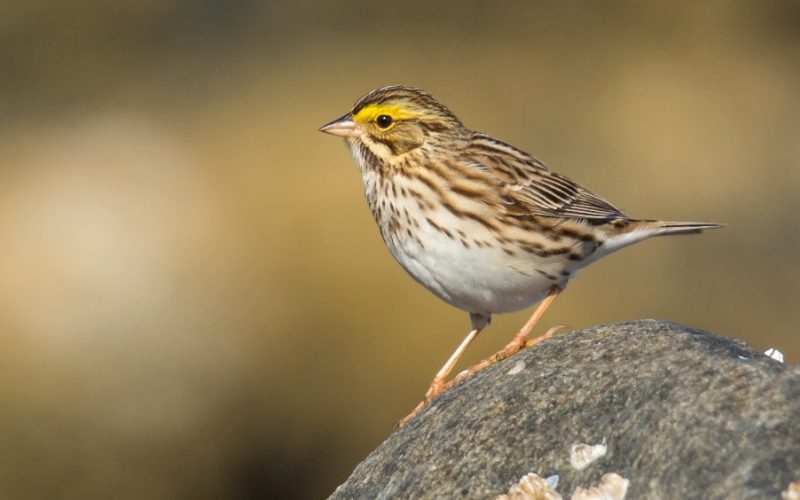
The Savannah Sparrow is a small, streaked sparrow about 5 inches long, characterized by its heavily streaked brown back and breast, pale underparts, and a short, yellowish patch above the eye. Its slim build and relatively short tail help distinguish it from other sparrows. The song is a complex series of trills and buzzes delivered from low perches.
Savannah Sparrows forage on the ground, feeding on seeds, grasses, and small insects. They inhabit open habitats such as grasslands, coastal meadows, and agricultural fields. Nesting occurs in shallow cups built low in grasses or on the ground, often well concealed to avoid predators.
In Oregon, Savannah Sparrows are widespread breeders across open fields, prairies, and coastal marshes. They are typically found year-round in many parts of the state but are more numerous during the breeding season. Their preference for open grassy habitats makes them a common sight in Oregon’s diverse open landscapes.
House Finch (Haemorhous mexicanus)
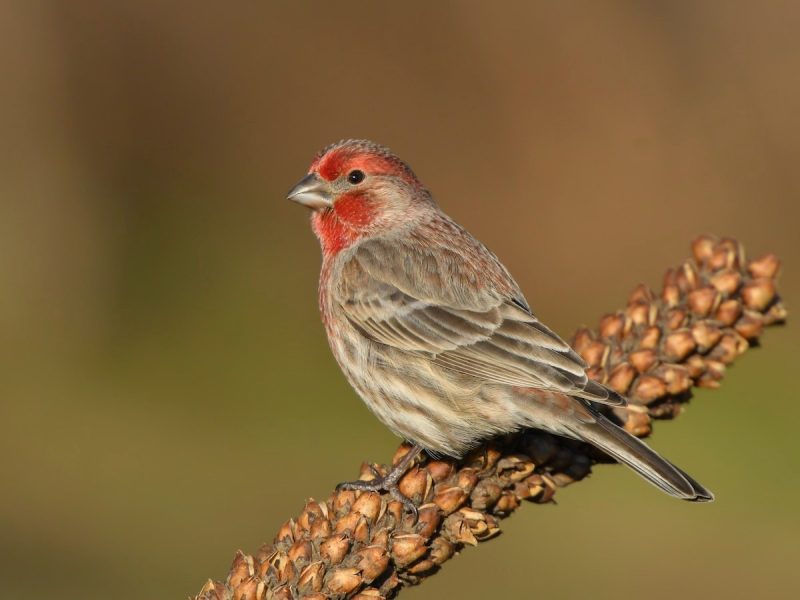
The House Finch is a small songbird about 6 inches long, known for its streaked brown body and bright red head, throat, and chest in males. Females lack the red coloring and are more uniformly brown and streaked. Their conical bills are adapted for cracking seeds, and their lively personalities make them common in urban and suburban areas.
House Finches are opportunistic feeders, primarily eating seeds, fruits, and occasional insects. They are highly social and often gather in flocks at feeders and open spaces. Their song is a cheerful, warbling series of notes that varies greatly among individuals. House Finches nest in a variety of sites, including building ledges, trees, and shrubs.
In Oregon, House Finches are widespread year-round residents, thriving in towns, cities, farms, and open woodland edges. Originally native to the southwestern U.S., they expanded their range northward and have adapted well to human environments, making them one of the most familiar and common birds across Oregon.
Purple Finch (Haemorhous purpureus)
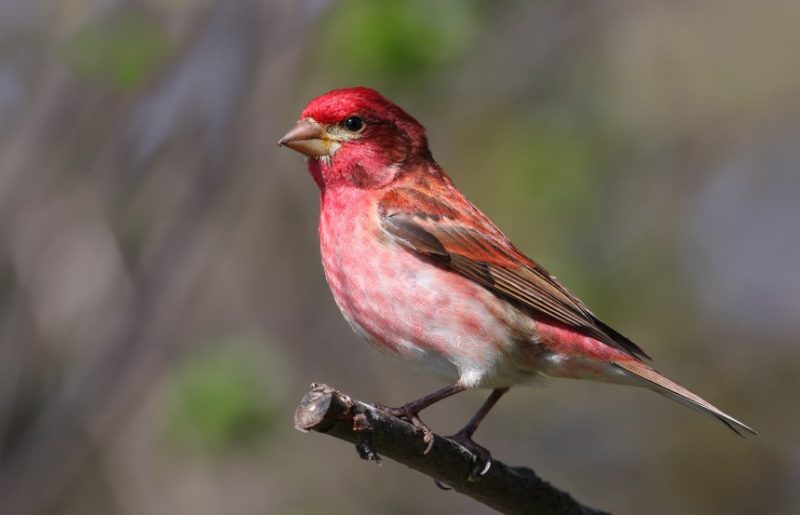
The Purple Finch is a small songbird measuring about 5.5 to 6 inches in length. Males are striking with rich raspberry-red coloring on the head, chest, and back, while females display streaky brown and white plumage, providing excellent camouflage in forested areas. Their slightly curved bill is perfect for cracking seeds, a major part of their diet.
This species favors mixed and coniferous forests, especially those with abundant pines, spruces, and firs. In Oregon, Purple Finches are commonly found in mountainous and foothill regions during the breeding season. Outside of breeding, they may also visit backyards and feeders, especially when natural food is scarce.
Purple Finches feed mainly on seeds from conifers and other trees, buds, and berries. Insects become an important part of their diet during the spring and summer months to provide protein for raising young. Their pleasant, warbling song is often heard in forest canopies, making them a delight for birdwatchers.
Common Redpoll (Acanthis flammea)
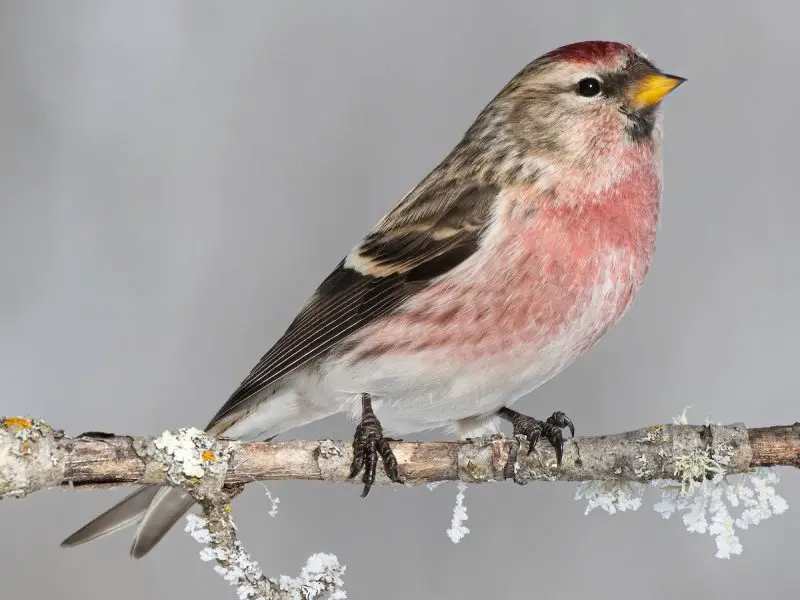
The Common Redpoll is a tiny finch, about 4.5 inches long, with a distinctive red patch on its forehead and a black chin. Its body is streaked with brown and white, and during winter, they often form large flocks that forage together. The males sometimes have a faint rosy wash on their breasts.
These birds breed in the Arctic tundra but migrate southward in the winter to places like Oregon. They are hardy birds that thrive in cold climates and are often seen in open woodlands, weedy fields, and areas with birch and alder trees. Their irruptive migration means their presence varies greatly from year to year.
Common Redpolls primarily eat seeds, especially from birch and alder catkins. They have a specialized throat pouch that allows them to store food to eat later, which is useful in harsh winter conditions. Occasionally, they supplement their diet with small insects during the breeding season.
Yellow-rumped Warbler (Setophaga coronata)
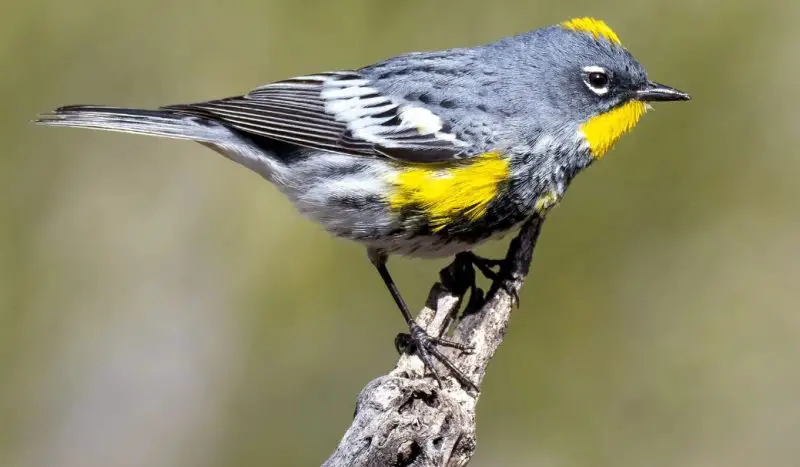
The Yellow-rumped Warbler is a small, agile songbird about 5 to 5.5 inches long. It is easily recognized by the bright yellow patches on its rump, sides, and crown, contrasted against gray, black, and white plumage. The species has two main subspecies, with some variation in coloring.
In Oregon, Yellow-rumped Warblers are common migrants during spring and fall and many also overwinter in the state. They prefer mixed forests, woodlands, and shrubby areas, often near water sources. Their adaptability allows them to exploit a wide range of habitats compared to other warblers.
Their diet mainly consists of insects, spiders, and other small invertebrates during the warmer months. In fall and winter, they switch to eating berries and fruit, which allows them to survive colder periods when insects are scarce. This flexibility in diet makes them one of the most widespread warblers in North America.
Wilson’s Warbler (Cardellina pusilla)

Wilson’s Warbler is a small, brightly colored songbird roughly 4 to 4.5 inches long. It is characterized by its vivid yellow face and underparts and a small but distinct black cap on the top of its head. Females tend to have a duller cap or none at all. Their sharp, thin bill is adapted for gleaning insects.
They breed in shrubby thickets, riparian woodlands, and moist forests throughout Oregon during spring and summer. These warblers prefer dense undergrowth where they can easily forage and nest. During migration, Wilson’s Warblers travel great distances, wintering in Mexico and Central America.
Their diet consists almost exclusively of insects, including caterpillars, beetles, and flies. Wilson’s Warblers are highly active feeders, often seen flitting through foliage catching prey mid-air or gleaning from leaves. Their sweet, high-pitched song is a common sound in Oregon’s forests in spring.
Orange-crowned Warbler (Leiothlypis celata)
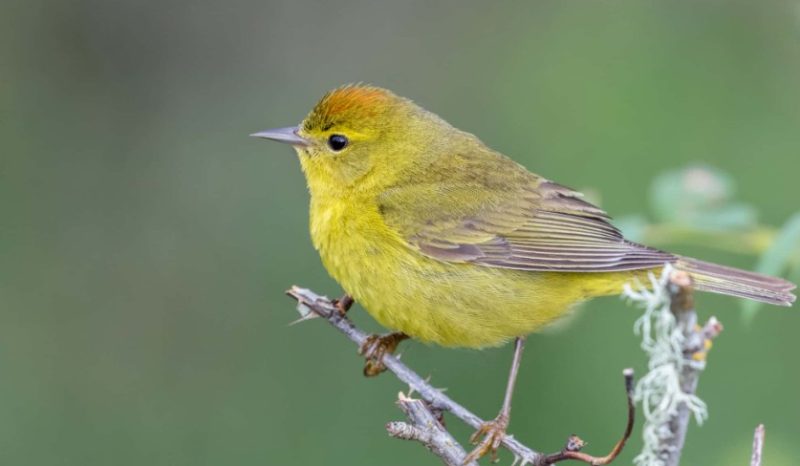
The Orange-crowned Warbler is a subtle yet charming small bird about 4.5 to 5 inches long. It has olive-green upperparts and pale yellow underparts, with faint streaking on the sides. The orange crown patch is usually hidden, visible only when the bird raises its feathers in display or alarm.
This species is a common breeder and migrant in Oregon, often found in a variety of habitats including open woodlands, shrubby areas, and gardens. It is one of the earliest warblers to return in spring and one of the latest to depart in fall, sometimes staying through mild winters.
Orange-crowned Warblers feed mainly on insects such as caterpillars, beetles, and spiders during the breeding season. In colder months, they switch to eating berries and small fruits. Their quiet, warbling song and subtle appearance make them a pleasant but often overlooked member of Oregon’s warbler community.
Western Tanager (Piranga ludoviciana)

The Western Tanager is a medium-sized songbird about 7 inches long, instantly recognizable by the male’s vibrant yellow body and striking red-orange head during the breeding season. Females are more subdued, with olive-yellow plumage and less pronounced coloration on the head. Their black wings with white bars add contrast to their bright body colors.
Western Tanagers primarily feed on insects and fruit, catching flying insects mid-air or gleaning from trees. Their behavior includes slow, deliberate movements among the tree canopy and occasional hovering to snatch prey. Their rich, robin-like song is a common sound in summer forests and woodlands.
In Oregon, Western Tanagers breed mainly in coniferous and mixed forests throughout the state, especially in mountainous and foothill areas. They migrate to Mexico and Central America in winter but are a vibrant summer presence in Oregon’s woodlands, favoring mature forests with abundant insect prey.
Black-headed Grosbeak (Pheucticus melanocephalus)
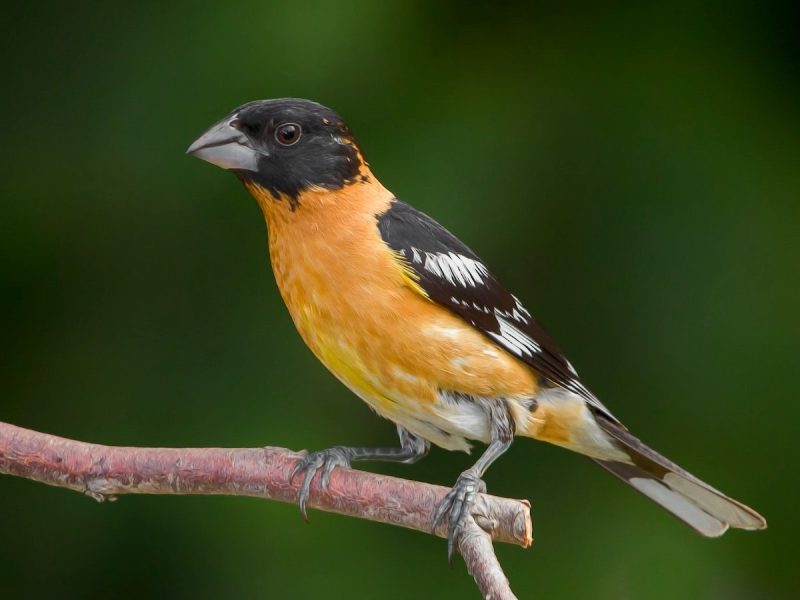
The Black-headed Grosbeak is a robust songbird about 7.5 inches long, with males displaying a striking combination of black heads, orange breasts, and yellow underparts. Females are paler with streaked brown and yellow tones, making them more camouflaged. Their thick, conical bills are powerful tools for cracking seeds and eating insects.
These grosbeaks feed on a varied diet, including seeds, fruits, and insects, often seen hopping on the ground or foraging in trees and shrubs. Their sweet, melodic whistles and songs add richness to the forest soundscape. They build bulky, cup-shaped nests in trees or large shrubs.
In Oregon, Black-headed Grosbeaks breed in woodlands, riparian areas, and forest edges, mostly in the western and southern parts of the state. They migrate southward during the winter but return annually to raise young in Oregon’s diverse forest habitats.
Frequently Asked Questions About Small Birds in Oregon
What types of habitats do small birds prefer in Oregon?
Small birds in Oregon inhabit a wide range of environments including dense forests, open woodlands, shrublands, wetlands, suburban gardens, and coastal areas. Species like the Pacific Wren favor moist coniferous forests, while others such as the Savannah Sparrow prefer open grasslands and meadows.
Are these small birds year-round residents or migratory?
Many small birds in Oregon are year-round residents, like the Black-capped Chickadee and Spotted Towhee. Others, including the Ruby-crowned Kinglet and American Tree Sparrow, are migratory, arriving seasonally to breed or overwinter depending on food availability and climate.
What do small birds commonly eat?
Small birds in Oregon have diverse diets, mostly consisting of insects, spiders, seeds, and berries. For example, warblers and kinglets focus on insects, while finches and sparrows rely heavily on seeds. Some species change their diet seasonally to adapt to food resources.
How do small birds adapt to urban environments?
Many species, such as the House Finch and House Wren, have adapted well to urban and suburban habitats by utilizing bird feeders, nesting in buildings, and foraging in gardens. Their flexible diets and nesting habits help them thrive alongside human development.
How can I attract small birds to my backyard in Oregon?
Planting native shrubs, providing fresh water, and offering feeders with seeds like sunflower or nyjer will attract various small birds. Creating shelter with dense vegetation and avoiding pesticides helps create a bird-friendly environment.

